Chapter 9 Rotational Motion and Angular Momentum
9.1 Rotation Angle and Angular Velocity
Summary
- Define arc length, rotation angle, radius of curvature and angular velocity.
- Calculate the angular velocity of a car wheel spin.
In 1D Kinematics, we studied motion along a straight line and introduced such concepts as displacement, velocity, and acceleration. 2D kinematics dealt with motion in two dimensions. Projectile motion is a special case of two-dimensional kinematics in which the object is projected into the air, while being subject to the gravitational force, and lands a distance away. In this chapter, we consider situations where the object does moves in a curve (a special case of this type of motion is uniform circular motion). We begin the study of rotational motion with rotation kinematics, and defining two angular quantities needed to describe this new type of motion.
Rotation Angle
When objects rotate about some axis—for example, when the CD (compact disc) in Figure 1 rotates about its center—each point in the object follows a circular arc. Consider a line from the center of the CD to its edge. Each pit used to record sound along this line moves through the same angle in the same amount of time. The rotation angle is the amount of rotation and is analogous to linear distance. We define the rotation angle Δθ to be the ratio of the arc length to the radius of curvature:
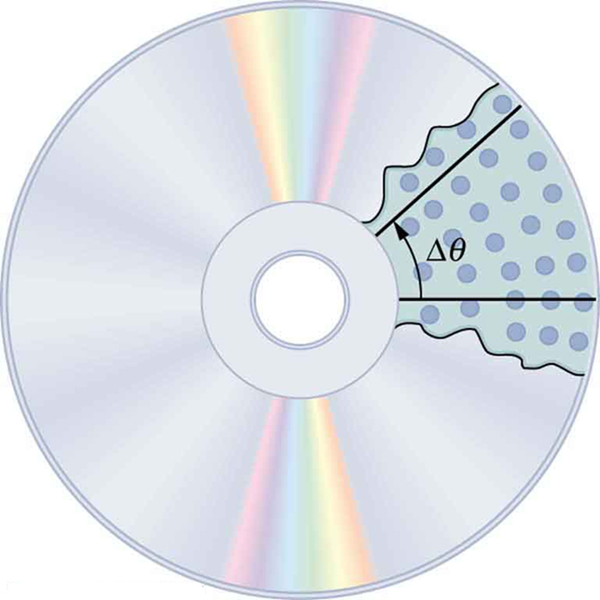
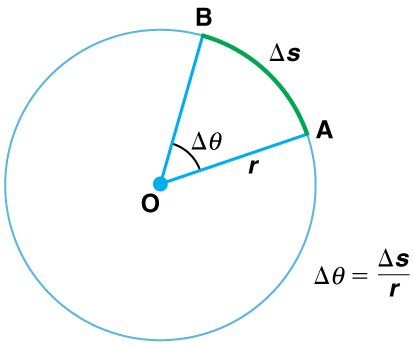
The arc length Δs is the distance traveled along a circular path as shown in Figure 2 Note that r is the radius of curvature of the circular path.
We know that for one complete revolution, the arc length is the circumference of a circle of radius r. The circumference of a circle is 2πr. Thus for one complete revolution the rotation angle is
This result is the basis for defining the units used to measure rotation angles, Δθ to be radians (rad), defined so that
A comparison of some useful angles expressed in both degrees and radians is shown in Table 1.
| Degree Measures | Radian Measure |
|---|---|
| [latex]30^0[/latex] | [latex]\dfrac{\pi}{6}[/latex] |
| [latex]60^0[/latex] | [latex]\dfrac{\pi}{3}[/latex] |
| [latex]90^0[/latex] | [latex]\dfrac{\pi}{2}[/latex] |
| [latex]120^0[/latex] | [latex]\dfrac{2\pi}{3}[/latex] |
| [latex]135^0[/latex] | [latex]\dfrac{3\pi}{4}[/latex] |
| [latex]180^0[/latex] | [latex]\pi[/latex] |
| Table 1. Comparison of Angular Units. | |
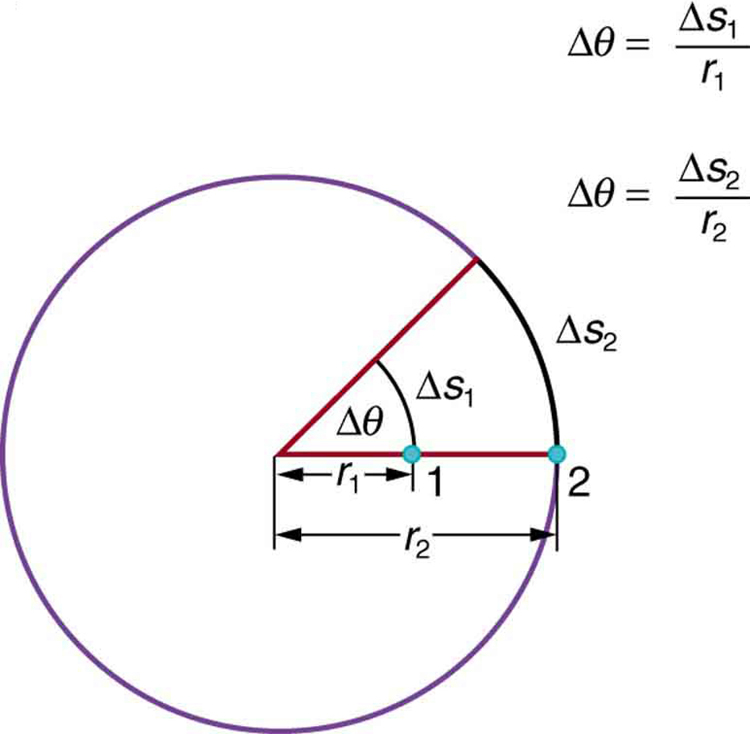
If Δθ = 2π rad, then the CD has made one complete revolution, and every point on the CD is back at its original position. Because there are 360° in a circle or one revolution, the relationship between radians and degrees is thus
so that
Angular Velocity
How fast is an object rotating? We define angular velocity ω as the rate of change of an angle. In symbols, this is
where an angular rotation Δθ takes place in a time Δt. The greater the rotation angle in a given amount of time, the greater the angular velocity. The units for angular velocity are radians per second (rad/s). Angular velocity is often expressed in units of rev/min (“rpm” or “revolutions per minute”). You can convert from rev/min to rad/s using the fact that that [latex]2\pi~\text{rad} = 1~\text{rev}[/latex] and 1 min = 60 sec.
Angular velocity ω is analogous to linear velocity v. To get the precise relationship between angular and linear velocity, we again consider a pit on the rotating CD. This pit moves an arc length Δs in a time Δt, and so it has a linear velocity
From [latex]\Delta\theta=\dfrac{\Delta{s}}{r}[/latex] we see that Δs = rΔθ. Substituting this into the expression for v gives
We write this relationship in two different ways and gain two different insights:
The first relationship in v = rω states that the linear velocity v is proportional to the distance from the center of rotation, thus, it is largest for a point on the rim (largest r), as you might expect. We can also call this linear speed v of a point on the rim the tangential speed. The second relationship in v = rω can be illustrated by considering the tire of a moving car. Note that the speed of a point on the rim of the tire is the same as the speed v of the car. See Figure 4. So the faster the car moves, the faster the tire spins—large v means a large ω, because v = rω. Similarly, a larger-radius tire rotating at the same angular velocity (ω) will produce a greater linear speed (v) for the car.
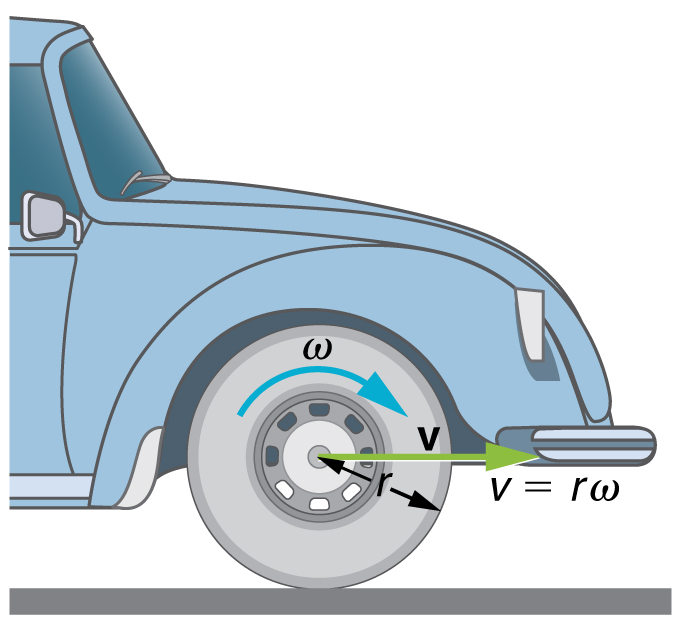
Example 1: How Fast Does a Car Tire Spin?
Calculate the angular velocity of a 0.300 m radius car tire when the car travels at 15.0 m/s (about 54 km/h). See Figure 4.
Strategy
Because the linear speed of the tire rim is the same as the speed of the car, we have v = 15.0 m/s. The radius of the tire is given to be r = 0.300 m. Knowing v and r, we can use the second relationship in v = rω, [latex]\omega=\dfrac{v}{r}[/latex] to calculate the angular velocity.
Solution
To calculate the angular velocity, we will use the following relationship:
Substituting the knowns,
Discussion
When we cancel units in the above calculation, we get 50.0/s. But the angular velocity must have units of rad/s. Because radians are actually unitless (radians are defined as a ratio of distance), we can simply insert them into the answer for the angular velocity. Also note that if an earth mover with much larger tires, say 1.20 m in radius, were moving at the same speed of 15.0 m/s, its tires would rotate more slowly. They would have an angular velocity
Both [latex]\omega~[/latex] and [latex]~v[/latex] have directions (hence they are angular and linear velocities, respectively). Angular velocity has only two directions with respect to the axis of rotation—it is either clockwise or counterclockwise. Linear velocity is tangent to the path, as illustrated in Figure 5.
Connection to Centripetal Acceleration
We call the acceleration of an object moving in uniform circular motion (resulting from a net external force) the centripetal acceleration (ac); centripetal means “toward the center” or “center seeking”. In Section 5.1, we saw that the magnitude of the centripetal acceleration is
which is the acceleration of an object in a circle of radius r at a speed v. It is also useful to express ac in terms of angular velocity. Substituting v = rω into the above expression, we find ac = (rω)2/r = rω2. We can express the magnitude of centripetal acceleration using either of two equations:
Example 2: How Big Is The Centripetal Acceleration in an Ultracentrifuge?
Calculate the centripetal acceleration of a point 7.50 cm from the axis of an ultracentrifuge spinning at 7.5 × 104 rev/min. Determine the ratio of this acceleration to that due to gravity. Note that this example is similar to Example 2 in the Section 5.2 on centripetal acceleration.
Strategy
The term rev/min stands for revolutions per minute. By converting this to radians per second, we obtain the angular velocity ω. Because r is given, we can use the second expression in the equation [latex]a_{\text{c}}=\dfrac{v^2}{r};~a_{\text{c}}=r\omega^2[/latex] to calculate the centripetal acceleration.
Solution
To convert 7.5 × 104 rev/min to radians per second, we use the facts that one revolution is 2π rad and one minute is 60.0 s. Thus,
Now the centripetal acceleration is given by the second expression in [latex]a_{\text{c}}=\dfrac{v^2}{r};~a_{\text{c}}=r\omega^2[/latex] as
Converting 7.50 cm to meters and substituting known values gives
Note that the unitless radians are discarded in order to get the correct units for centripetal acceleration. Taking the ratio of ac to g yields
Discussion
This last result means that the centripetal acceleration is 472,000 times as strong as g. It is no wonder that such high ω centrifuges are called ultracentrifuges. The extremely large accelerations involved greatly decrease the time needed to cause the sedimentation of blood cells or other materials.
TAKE-HOME EXPERIMENT
Tie an object to the end of a string and swing it around in a horizontal circle above your head (swing at your wrist). Maintain uniform speed as the object swings and measure the angular velocity of the motion. What is the approximate speed of the object? Identify a point close to your hand and take appropriate measurements to calculate the linear speed at this point. Identify other circular motions and measure their angular velocities.
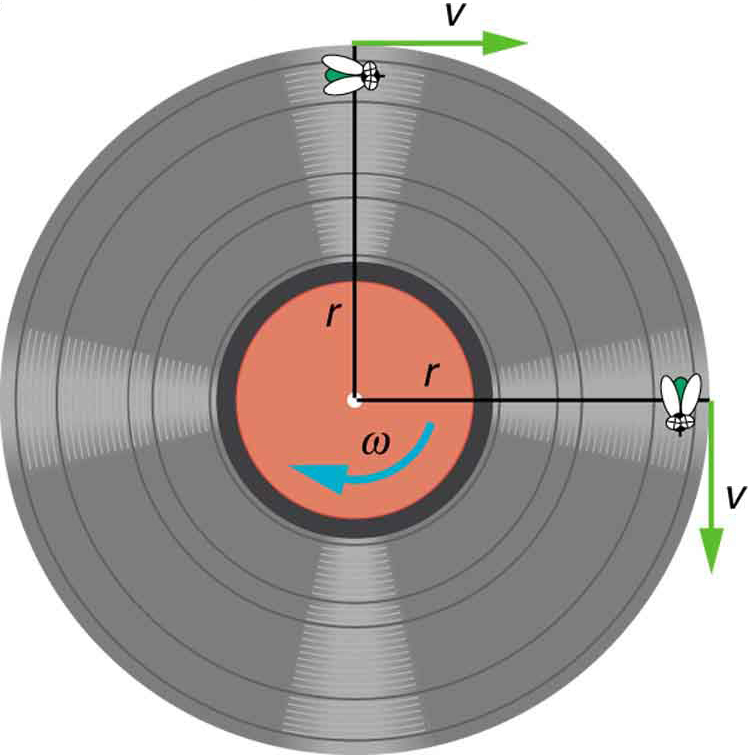
PHET EXPLORATIONS: LADYBUG REVOLUTION

Join the ladybug in an exploration of rotational motion. Rotate the merry-go-round to change its angle, or choose a constant angular velocity or angular acceleration. Explore how circular motion relates to the bug’s x,y position, velocity, and acceleration using vectors or graphs.
Section Summary
- Uniform circular motion is motion in a circle at constant speed. The rotation angle Δθ is defined as the ratio of the arc length to the radius of curvature:
[latex]\Delta\theta=\dfrac{\Delta{s}}{r},[/latex]
where arc length Δs is distance traveled along a circular path and r is the radius of curvature of the circular path. The quantity Δθ is measured in units of radians (rad), for which
[latex]2\pi~\text{rad}=360^0=1~\text{revolution}.[/latex] - The conversion between radians and degrees is 1 rad = 57.3°.
- Angular velocity ω is the rate of change of an angle,
[latex]\omega=\dfrac{\Delta\theta}{\Delta{t}},[/latex]
where a rotation Δθ takes place in a time Δt. The units of angular velocity are radians per second (rad/s). Linear velocity v and angular velocity ω are related by
[latex]v=r\omega~\text{or}~\omega=\dfrac{v}{r}.[/latex]
Glossary
- arc length
- Δs, the distance traveled by an object along a circular path
- pit
- a tiny indentation on the spiral track moulded into the top of the polycarbonate layer of CD
- rotation angle
- the ratio of the arc length to the radius of curvature on a circular path:
[latex]\Delta\theta=\dfrac{\Delta{s}}{r}[/latex]
- radius of curvature
- radius of a circular path
- radians
- a unit of angle measurement
- angular velocity
- ω, the rate of change of the angle with which an object moves on a circular path
Conceptual Questions
1: There is an analogy between rotational and linear physical quantities. What rotational quantities are analogous to distance and velocity?
Problems & Exercises
1: Semi-trailer trucks have an odometer on one hub of a trailer wheel. The hub is weighted so that it does not rotate, but it contains gears to count the number of wheel revolutions—it then calculates the distance traveled. If the wheel has a 1.15 m diameter and goes through 200,000 rotations, how many kilometers should the odometer read?
2: Microwave ovens rotate at a rate of about 6 rev/min. What is this in revolutions per second? What is the angular velocity in radians per second?
3: An automobile with 0.260 m radius tires travels 80,000 km before wearing them out. How many revolutions do the tires make, neglecting any backing up and any change in radius due to wear?
4: (a) What is the period of rotation of Earth in seconds? (b) What is the angular velocity of Earth? (c) Given that Earth has a radius of 6.4 × 106 m at its equator, what is the linear velocity at Earth’s surface?
5: A baseball pitcher brings his arm forward during a pitch, rotating the forearm about the elbow. If the velocity of the ball in the pitcher’s hand is 35.0 m/s and the ball is 0.300 m from the elbow joint, what is the angular velocity of the forearm?
6: In lacrosse, a ball is thrown from a net on the end of a stick by rotating the stick and forearm about the elbow. If the angular velocity of the ball about the elbow joint is 30.0 rad/s and the ball is 1.30 m from the elbow joint, what is the velocity of the ball?
7: A truck with 0.420-m-radius tires travels at 32.0 m/s. What is the angular velocity of the rotating tires in radians per second? What is this in rev/min?
8: A rotating space station is said to create “artificial gravity”—a loosely-defined term used for an acceleration that would be crudely similar to gravity. The outer wall of the rotating space station would become a floor for the astronauts, and centripetal acceleration supplied by the floor would allow astronauts to exercise and maintain muscle and bone strength more naturally than in non-rotating space environments. If the space station is 200 m in diameter, what angular velocity would produce an “artificial gravity” of 9.80 m/s2 at the rim?
9: An ordinary workshop grindstone has a radius of 7.50 cm and rotates at 6500 rev/min.
(a) Calculate the magnitude of the centripetal acceleration at its edge in meters per second squared and convert it to multiples of g.
(b) What is the linear speed of a point on its edge?
10: Helicopter blades withstand tremendous stresses. In addition to supporting the weight of a helicopter, they are spun at rapid rates and experience large centripetal accelerations, especially at the tip.
(a) Calculate the magnitude of the centripetal acceleration at the tip of a 4.00 m long helicopter blade that rotates at 300 rev/min.
(b) Compare the linear speed of the tip with the speed of sound (taken to be 340 m/s).
11: Olympic ice skaters are able to spin at about 5 rev/s.
(a) What is their angular velocity in radians per second?
(b) What is the centripetal acceleration of the skater’s nose if it is 0.120 m from the axis of rotation?
(c) An exceptional skater named Dick Button was able to spin much faster in the 1950s than anyone since—at about 9 rev/s. What was the centripetal acceleration of the tip of his nose, assuming it is at 0.120 m radius?
(d) Comment on the magnitudes of the accelerations found. It is reputed that Button ruptured small blood vessels during his spins.
12: Verify that the linear speed of an ultracentrifuge is about 0.50 km/s, and Earth in its orbit is about 30 km/s by calculating:
(a) The linear speed of a point on an ultracentrifuge 0.100 m from its center, rotating at 50,000 rev/min.
(b) The linear speed of Earth in its orbit about the Sun (use data from the text on the radius of Earth’s orbit and approximate it as being circular).
13: At takeoff, a commercial jet has a 60.0 m/s speed. Its tires have a diameter of 0.850 m.
(a) At how many rev/min are the tires rotating?
(b) What is the centripetal acceleration at the edge of the tire?
(c) With what force must a determined 1.00 × 10-15 kg bacterium cling to the rim?
(d) Take the ratio of this force to the bacterium’s weight.
14: Integrated Concepts
When kicking a football, the kicker rotates his leg about the hip joint.
(a) If the velocity of the tip of the kicker’s shoe is 35.0 m/s and the hip joint is 1.05 m from the tip of the shoe, what is the shoe tip’s angular velocity?
(b) The shoe is in contact with the initially stationary 0.500 kg football for 20.0 ms. What average force is exerted on the football to give it a velocity of 20.0 m/s?
(c) Find the maximum range of the football, neglecting air resistance.
15: Construct Your Own Problem
Consider an amusement park ride in which participants are rotated about a vertical axis in a cylinder with vertical walls. Once the angular velocity reaches its full value, the floor drops away and friction between the walls and the riders prevents them from sliding down. Construct a problem in which you calculate the necessary angular velocity that assures the riders will not slide down the wall. Include a free body diagram of a single rider. Among the variables to consider are the radius of the cylinder and the coefficients of friction between the riders’ clothing and the wall.
Solutions
Problems & Exercises
1: 723 km
3: 5 x 107 rotations
5: 117 rad/s
7: 76.2 rad/s 728 rpm
9: (a) 3.47 x 104 m/s2, 3.55 x 103 g (b) 51.1 m/s
11: (a) 31.4 rad/s (b) 118 m/s (c) 384 m/s (d) The centripetal acceleration felt by Olympic skaters is 12 times larger than the acceleration due to gravity. That’s quite a lot of acceleration in itself. The centripetal acceleration felt by Button’s nose was 39.2 times larger than the acceleration due to gravity. It is no wonder that he ruptured small blood vessels in his spins.
13: (a) 1.35 x 103 rpm (b) 8.47 x 103 m/s2 (c) 8.47 x 10-12 N (d) 865
14: (a) 33.3 rad/s (b) 500 N (c) 40.8 m

